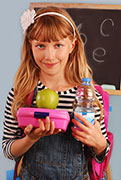
TUESDAY, March 24, 2015 (HealthDay News) — Packing school lunches that kids will like and are easy to eat can be a challenge, according to Amy Reed, a registered dietitian at Cincinnati Children’s Hospital.
Even when parents carefully craft sandwiches into fun shapes, stack fruit kabobs to resemble animals and chop veggies to look like a rainbow, these foods may come home uneaten. Reed explained there are many reasons why kids may pass on these seemingly enticing foods, including:
- Time constraints. All schools are different, but some students get only a 15-minute window to eat their lunch. This is often not enough time for young kids, who are likely socializing, to eat.
- A desire to stay clean. Some kids choose not to eat lunch if they feel their meal would be too messy.
- Loose teeth. Children with loose or missing teeth may have more trouble eating certain foods.
- Too many choices: Some kids may be overwhelmed if there is too much food packed into their lunch box.
But, there are ways parents can sidestep some of these issues and help ensure their children eat a healthy lunch at school. Reed offered the following suggestions:
- Don’t overpack. For children who have a limited time to eat their lunch or feel overwhelmed by too much food, provide smaller portions of food. This doesn’t mean the lunch should be less nutritious. Be sure to provide a limited serving of foods from at least four food groups.
- Limit containers. It may take a lot of time for children to open just one container. If they need to open a few, it could use up valuable time they need to eat their lunch. In some cases, small children may not be able to open certain containers at all. Try packing kids’ lunches in a bento box – one container that has a few small compartments with a lid on top.
- Make sure food is easy to eat. Children who have loose or missing teeth may need to eat foods that don’t require biting with their front teeth and can be chewed on the side of the mouth, such as lunch meat, lettuce and cheese rolled-up (instead of a sandwich); thin slices of pineapple, apples or pears; and cheese sticks, squeeze yogurt and fruit pouches.
- Limit treats. Children may choose to eat treats first. If they have limited time, this may be all they eat. Some kids may also fill up on treats and never try the other more nutritious foods in their lunch box.
- Seek advice. For kids who have medical problems, food allergies or sensory issues, eating a variety of foods may be more difficult. Parents who are concerned about their child’s food intake can get help from their pediatrician and a registered dietitian.
More information
The Academy of Nutrition and Dietetics provides more tips on school lunches.
Copyright © 2025 HealthDay. All rights reserved.

